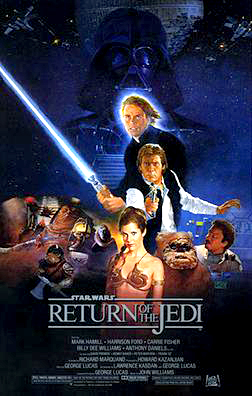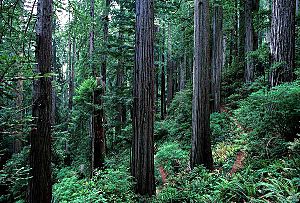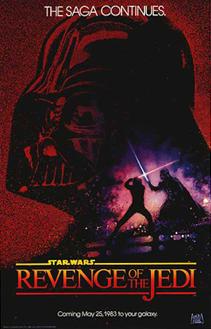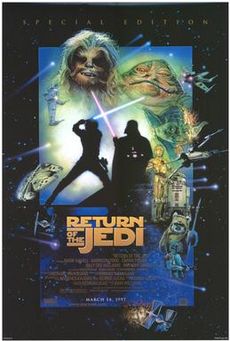Return of the Jedi facts for kids
Quick facts for kids Return of the Jedi |
|
|---|---|

Theatrical release poster by Kazuhiko Sano
|
|
| Directed by | Richard Marquand |
| Produced by | Howard Kazanjian |
| Screenplay by | |
| Story by | George Lucas |
| Starring | |
| Music by | John Williams |
| Cinematography | Alan Hume |
| Editing by |
|
| Studio | Lucasfilm Ltd. |
| Distributed by | 20th Century Fox |
| Release date(s) | May 25, 1983 (United States) |
| Running time | 132 minutes |
| Country | United States |
| Language | English |
| Budget | $32.5–42.7 million |
| Money made | $475.1 million |
Return of the Jedi (also known as Star Wars: Episode VI – Return of the Jedi) is an exciting space opera movie from 1983. It was directed by Richard Marquand. The story was created by George Lucas, who also wrote the screenplay with Lawrence Kasdan. This film is the third part of the original Star Wars movies. It is also the sixth film in the "Skywalker saga" series. The story happens one year after the events of The Empire Strikes Back. The movie stars Mark Hamill, Harrison Ford, Carrie Fisher, Billy Dee Williams, Anthony Daniels, David Prowse, Kenny Baker, Peter Mayhew, and Frank Oz.
In the film, the evil Galactic Empire is building a new, super-powerful Death Star. This new weapon is meant to finally crush the Rebel Alliance. The Emperor himself plans to watch over its final construction. To stop this, the Rebel Fleet plans a huge attack on the Death Star. Their goal is to destroy it before it's finished and defeat the Emperor. At the same time, Luke Skywalker, who is now a Jedi Knight, tries to bring his father, Darth Vader, back to the good side of the Force.
The movie was released on May 25, 1983. This was exactly six years after the very first Star Wars movie came out. It received mostly good reviews from critics. It earned $374 million when it first came out, making it the highest-earning film of 1983. Over the years, the movie has been re-released and updated several times. This has brought its total earnings to $475 million.
Contents
Movie Story
A year after Han Solo was captured, C-3PO and R2-D2 go to the palace of the crime lord Jabba the Hutt on Tatooine. They are part of a plan by Luke Skywalker to rescue Han. Princess Leia sneaks into the palace disguised as a bounty hunter. She pretends to collect a reward for Chewbacca and then frees Han. But she gets caught and is made Jabba's slave. Luke soon arrives to try and free his friends. Jabba drops him into a pit with a monster called a rancor. Luke defeats the rancor. Jabba then sentences Luke, Han, and Chewbacca to be eaten by the Sarlacc, a dangerous creature in the desert.
Luke had hidden his new lightsaber inside R2-D2. He uses it to free himself and his friends. They fight Jabba's guards. During the fight, Boba Fett falls into the Sarlacc after Han accidentally damages his jetpack. Leia then strangles Jabba to death with her chains. The group destroys Jabba's ship and escapes.
While the others meet up with the Rebel Alliance, Luke goes back to Dagobah. He wants to finish his Jedi training with Yoda. He finds out that Yoda is dying. Yoda confirms that Darth Vader is Luke's father and that there is another Skywalker. Yoda then disappears and becomes one with the Force. The Obi-Wan Kenobi's Force ghost then tells Luke that Leia is his twin sister. He also says Luke must face Vader again to complete his training and defeat the Empire.
The Alliance learns that the Empire is building a second Death Star. The Emperor is watching over its construction. The station is protected by an energy shield. Han leads a team, including Luke, Leia, and Chewbacca, to destroy the shield generator on the forest moon of Endor. This will allow the Rebel Fleet to attack the Death Star. The team uses a stolen Imperial ship to land without being noticed. They meet a tribe of Ewoks and become friends with them. Later, Luke tells Leia that she is his sister and Vader is their father. He says he must face Vader. Luke gives himself up to Imperial troops and is taken to Vader. He tries to convince Vader to leave the dark side, but he fails.
Vader takes Luke to meet the Emperor. The Emperor wants to turn Luke to the dark side. He tells Luke that his friends and the Rebel Fleet are flying into a trap. On Endor, Han's team is captured by Imperial soldiers. But the Ewoks fight back, allowing the Rebels to get inside the shield generator. Meanwhile, Lando Calrissian in the Millennium Falcon and Admiral Ackbar lead the Rebel attack on the second Death Star. They find its shield is still up, and the Imperial fleet is waiting for them.
The Emperor tells Luke that the Death Star is ready to fire. He orders its superlaser to destroy a Rebel ship. He tries to make Luke angry. Luke tries to attack the Emperor, but Vader stops him. They have a lightsaber duel. Vader senses that Luke has a sister. He threatens to turn her to the dark side if Luke doesn't join him. Luke gets very angry and defeats Vader, cutting off his robotic hand. The Emperor tells Luke to kill Vader and take his place. But Luke refuses, saying he is a Jedi like his father. The Emperor gets furious and tortures Luke with Force lightning. Vader cannot let his son die. He betrays the Emperor and throws him down a reactor shaft, killing him. But Vader is badly hurt. Luke removes Vader's mask, and the good Anakin Skywalker dies.
After Han's team destroys the shield generator, Lando leads Rebel fighters into the Death Star's center. The Rebel fleet destroys the Imperial flagship, the Executor. Lando and X-wing fighter pilot Wedge Antilles destroy the Death Star's main power core. They escape just before the station explodes. Luke escapes in a ship with his father's body. On Endor, Leia tells Han that Luke is her brother. Luke burns his father's body on a pyre and meets up with his friends. The Rebels and the galaxy celebrate the Empire's defeat. Luke sees the spirits of Yoda, Obi-Wan, and Anakin watching over him.
Main Characters
- Mark Hamill as Luke Skywalker: He is one of the last Jedi Knights. He was trained by Obi-Wan Kenobi and Yoda. He is Leia's twin brother, Han's friend, and Darth Vader's son. He is also a skilled X-wing fighter pilot for the Rebellion.
- Harrison Ford as Han Solo: He is the captain of the Millennium Falcon. He becomes a General in the Rebellion. He is Luke's friend and Leia's boyfriend.
- Carrie Fisher as Leia Organa: She was the princess of the destroyed planet Alderaan. She is a leader of the Rebellion, Luke's twin sister, and Han's girlfriend.
- Billy Dee Williams as Lando Calrissian: He used to be in charge of Cloud City. He becomes a General in the Rebellion. He is Han's old friend and used to own the Millennium Falcon.
- Anthony Daniels as C-3PO: He is a robot (protocol droid) who works for the Rebellion. He is R2-D2's longtime friend.
- Peter Mayhew as Chewbacca: He is a Wookiee and Han's loyal friend and co-pilot of the Millennium Falcon. He is part of the Rebellion.
- Kenny Baker as
- Ian McDiarmid as The Emperor: He is the evil leader of the Galactic Empire and Darth Vader's master.
- Frank Oz as Yoda: A very old and wise Jedi Master who trained Luke. He lives on Dagobah.
- David Prowse as Darth Vader: A powerful Sith Lord and the Emperor's main helper. He is Luke and Leia's father.
- James Earl Jones provides the voice for Darth Vader.
- Sebastian Shaw plays Anakin Skywalker when his mask is removed and as a Force ghost.
- Alec Guinness as Obi-Wan Kenobi: Luke's wise Jedi teacher who continues to guide Luke as a Force ghost.
Other important characters include Denis Lawson as Wedge Antilles, an X-wing pilot. Kenneth Colley plays Admiral Piett, and Jeremy Bulloch plays bounty hunter Boba Fett. Michael Pennington plays Moff Jerjerrod, who is in charge of the second Death Star. Warwick Davis plays Wicket W. Warrick, an Ewok who becomes friends with Leia. Caroline Blakiston plays Mon Mothma, a leader of the Rebel Alliance. Many puppeteers, voice actors, and stunt performers helped bring the many alien characters to life.
Making the Movie
Filming the Scenes
Filming for Return of the Jedi started on January 11, 1982, and ended on May 20, 1982. This was a shorter filming schedule than the previous movie. The goal was to give Industrial Light & Magic (ILM), the special effects company, more time to work. The movie had a budget of $32.5 million. George Lucas wanted to avoid going over budget, which had happened with The Empire Strikes Back.
The movie was filmed under the fake name Blue Harvest. This was done to keep the real project a secret from fans and the press. It also helped prevent companies from charging more money for services.
The first part of filming took place at Elstree Studios in England. They used all nine sound stages there. One challenging scene was Luke Skywalker's fight with the rancor monster. After trying different ways, they decided to film the rancor using a high-speed puppet. In April, the crew moved to the Yuma Desert in Arizona for two weeks to film outdoor scenes on Tatooine. Then, production moved to the redwood forests of northern California. They spent two weeks filming the Endor forest scenes. Finally, they finished filming at ILM in San Rafael, California for special effects shots.
Movie Music
John Williams composed and conducted the music for the film. The London Symphony Orchestra performed the score. The movie's soundtrack was first released by RSO Records in the United States.
Special Effects Work
The special effects work at ILM was very busy. Even though they had learned a lot from the first two movies, they wanted to make the effects even better for this final film. The team had to work long hours, often 20 hours a day, six days a week, to finish everything on time.
Movie Release
Return of the Jedi was released in theaters on May 25, 1983. It was originally planned for May 27, but they changed it to match the release date of the first Star Wars movie in 1977. When it first came out, the movie was advertised as Star Wars: Return of the Jedi.
In 1997, for the 20th anniversary of Star Wars, George Lucas re-released the original Star Wars movies as "Special Editions." Return of the Jedi was re-released on March 7, 1997. These versions included some changes and new scenes. For example, new alien band members were added to Jabba's throne room, and the Sarlacc monster was changed.
Name Change
The first advertisements for the movie called it Revenge of the Jedi. But in December 1982, George Lucas decided that "Revenge" was not a good word for a Jedi. Jedi are not supposed to seek revenge. So, he changed the title back to his original idea, Return of the Jedi. Thousands of "Revenge" posters had already been printed. Lucasfilm stopped sending them out and sold the remaining posters to Star Wars fan club members.
Later, in 2005, a prequel movie called Star Wars: Episode III – Revenge of the Sith was released. Its title was a nod to the original name considered for Return of the Jedi.
Watching at Home
Return of the Jedi has been released many times for people to watch at home. It first came out on VHS and Laserdisc tapes. Later, the Special Edition was also released on these formats.
On September 21, 2004, all three original Star Wars films were released together on DVD. These versions had more changes made by George Lucas. The movies were improved digitally. The DVD set also included extra features like documentaries and behind-the-scenes videos.
Later, with the release of Episode III: Revenge of the Sith, Lucas made more changes to Return of the Jedi. For example, the ghost of Anakin Skywalker at the end of the movie was changed to look like the actor who played Anakin in the prequel movies. The original versions of the films were also released on DVD in 2006.
A Blu-ray version of the Star Wars saga was released in 2011. This version included some scenes that were cut from the movie. These included a sandstorm scene and a scene where Darth Vader talks to Luke using the Force. The movie has also been released digitally and in 4K resolution for streaming.
Other Stories and Adaptations
Book Version
A book version of Return of the Jedi was written by James Kahn. It was released on May 12, 1983, a few days before the movie came out.
Radio Show
A three-hour radio show based on the film was made in 1996. It was broadcast on National Public Radio. Anthony Daniels played C-3PO again, just like in the movie.
Comic Book
Marvel Comics published a comic book version of the film. It was written by Archie Goodwin and drawn by several artists.
Children's Book and Record
A special book-and-record set was made for children in 1983. It had a 24-page book with pictures from the movie and a record that told a shorter version of the story.
Other Star Wars Movies
A prequel trilogy of Star Wars movies started with Star Wars: Episode I – The Phantom Menace in 1999. These movies take place about 30 years before the original trilogy. A sequel trilogy started with Episode VII – The Force Awakens in 2015. These movies are set 30 years after Return of the Jedi.
See also
 In Spanish: Star Wars: Episode VI - Return of the Jedi para niños
In Spanish: Star Wars: Episode VI - Return of the Jedi para niños




